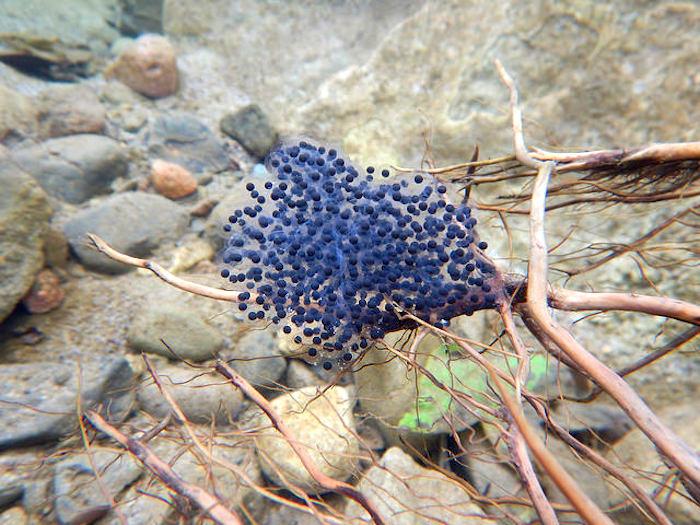
Egg masses were discovered on March 14, 2017, for the first time during a reintroduction project to bring back California red-legged frogs to the Santa Monica Mountains. The species is listed as threatened under the Endangered Species Act./NPS
National Park Service researchers surveying a stream in Santa Monica Mountains National Recreation Area last week spotted signs of California red-legged frog reproduction. The nine egg masses found are the first known evidence in recent times of the species sustaining a population in the Santa Monica Mountains without the help of humans.
California red-legged frogs, popularized by Mark Twain in the 1865 story The Celebrated Jumping Frog of Calaveras County, are listed as threatened under the Endangered Species Act. The species has not been seen in the Santa Monica Mountains since the 1970s, according to a National Park Service release. A population discovered in the nearby Simi Hills in 1999 has been used to replenish the species in four spots in the mountains for the past four years. The idea was that translocated populations would eventually mature, mate, and reproduce on their own. Last week's sighting, on March 14 at an undisclosed location, confirmed that the reintroduction project is headed in the right direction.
"I was literally crying when the stream team showed me the photos of egg masses," said Katy Delaney, a National Park Service ecologist with Santa Monica Mountains National Recreation Area. "The years of work we've put in is showing amazing progress. There's still plenty of work to be done, but this is a major moment for the project."
“When I heard the news that California red-legged frogs were breeding at one of the translocation sites, I was beyond thrilled. This success shows how collaborative, voluntary partnerships are truly making a difference for rare, native wildlife in Southern California,” said Chris Dellith, senior fish and wildlife biologist with the U.S. Fish and Wildlife Service’s Ventura Fish and Wildlife Office, which expanded translocation efforts beyond National Park Service lands to state parks in the Santa Monica Mountains through a Safe Harbor Agreement. Such agreements provide the opportunity for private and non-federal landowners to proactively support the recovery of rare wildlife by restoring or managing habitat, with assurances that other land-uses, like visitor recreation opportunities or maintenance activities, are not restricted.
“Because we have now seen breeding success, we are extremely hopeful that breeding will continue to occur at other translocation sites over the next few years,” Dellith added.
Delaney and the team will continue to translocate egg masses from the Simi Hills source population through at least next spring. After that, they'll monitor the population along with other aquatic species annually as part of an ongoing long-term monitoring protocol.
Partners in the reintroduction project are California State Parks, the Mountains Recreation and Conservation Authority, the U.S. Fish and Wildlife Service, the Santa Monica Bay Restoration Commission, the Santa Barbara Zoo, and U.S. Geological Survey (USGS).
But the National Park Service is seeking another large partnership for the project--and that’s with the public.
Park rangers are asking visitors to continue stewardship of their public lands by treading lightly around aquatic habitat. For example, hiking at the edge of water features, such as waterfalls, streams, and ponds, can create erosion, which could dam and dry out areas downstream.

California red-legged frogs in amplexus, a mating behavior in which the male (on top) fertilizes eggs as they are released from the female/NPS
California red-legged frogs (Rana draytonii) require deep pools of year-round water, which are not easy to find in the arid climate of the Santa Monica Mountains. Many of the streams in the Santa Monica Mountains are infested with non-native species like crayfish, which can prey on frog eggs and tadpoles. The amphibians have been extirpated from 70 percent of its range.
Because frogs generally have permeable skin that easily absorbs contaminants, they are considered an indicator species that provides important information about habitat health. Nationwide, USGS has documented precipitous declines among amphibians, which some speculate may be linked to habitat loss, invasive species, and pollution.


 Support Essential Coverage of Essential Places
Support Essential Coverage of Essential Places







Add comment